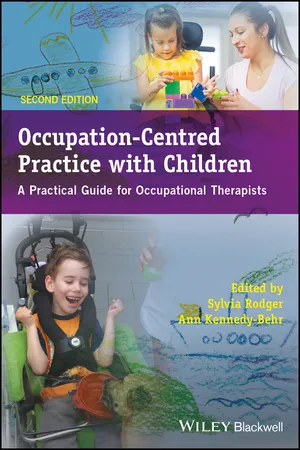
Occupation-Centred Practice with Children
A Practical Guide for Occupational Therapists
- English
- ePUB (mobile friendly)
- Available on iOS & Android
Occupation-Centred Practice with Children
A Practical Guide for Occupational Therapists
About this book
Occupation-Centred Practice with Children remains the only occupational therapy book which supports the development and implementation of occupation-centred practice with children. Drawing on the latest occupational therapy theory and research, this new edition has been fully updated throughout, and includes new chapters on occupational transitions for children and young people, assessing children's occupations and participation, intervention within schools, the arts and children's occupational opportunities, as well as using animals to support children's occupational engagement.
Key features:
- Written by an international expert team of contributors.
- Each chapter begins with preliminary questions to assist with consideration of current knowledge, and then reflection questions at the conclusion to allow revision of key content in order to support independent learning.
- Highly practical, with a range of case studies, key point summaries, reflective questions, best practice guidelines, and a range of tools, interventions and techniques to aid applications to practice.
- A new appendix outlining all the assessments referred to in the book has now been included.
Occupation-Centred Practice with Children is a practical, theoretically grounded and evidence based guide to contemporary occupational therapy practice, and is important reading for all occupational therapy students and therapists wishing to make a real difference to children and their families' lives.
Frequently asked questions
- Essential is ideal for learners and professionals who enjoy exploring a wide range of subjects. Access the Essential Library with 800,000+ trusted titles and best-sellers across business, personal growth, and the humanities. Includes unlimited reading time and Standard Read Aloud voice.
- Complete: Perfect for advanced learners and researchers needing full, unrestricted access. Unlock 1.4M+ books across hundreds of subjects, including academic and specialized titles. The Complete Plan also includes advanced features like Premium Read Aloud and Research Assistant.
Please note we cannot support devices running on iOS 13 and Android 7 or earlier. Learn more about using the app.
Information
Chapter 1
Introduction to Occupation‐centred Practice for Children
If we don’t stand up for children, then we don’t stand for much.
Marian Wright Edelman
Preliminary questions
- Why a book on occupation‐centred practice for children?
- Think about your childhood: what did you most like doing?
- Think about your childhood: what did you least like doing?
- What were the environments that you engaged in (e.g. home, park, school, neighbourhood)? How did they afford opportunities for occupation?
- Did you play sports, learn an instrument or go to clubs or organised activities?
- How might your childhood be different to those of children today?
- How might living in the city vs country, suburb vs. high rise impact on children’s occupations?
Introduction
- Briefly describe the resurgence of occupation within the occupational therapy profession.
- Outline some global trends that have occurred in parallel with the refocusing of the profession.
- Describe some of the challenges to traditional developmental theory that has historically informed occupational therapy practice with children, as well as emerging views and theories of occupational development that have the potential to better inform our practice with children and their families.
- Identify the impact of these professional and global trends on occupational therapy practice with children.


- People have the right to participate in a range of occupations that enable them to flourish, fulfil their potential and experience satisfaction in a way consistent with their culture and beliefs.
- People have the right to be supported to participate in occupation, through engaging in occupation, to become valued members of their family, community and society.
- People have the right to choose for themselves, to be free from pressure, force or coercion, in participating in occupations that may threaten safety, survival and health, and those occupations that are de‐humanising, degrading or illegal.
- The right to occupation encompasses civic, educative, productive, social, creative, spiritual and restorative occupations.
- At a societal level the right to occupation is underpinned by the valuing of each person’s unique contribution to the valued and meaningful occupations of society and is ensured by equitable access to participation regardless of difference.
- Abuses to the right to occupation may take the form of economic, social or physical exclusion through attitudinal or physical barriers, or through control of access to necessary knowledge, skills, and resources, or venues where occupation takes place.
- Global conditions that threaten the right to occupation include poverty, disease, social discrimination, displacement, natural and man‐made disasters, and armed conflict.
Table of contents
- Cover
- Title Page
- Table of Contents
- Notes on Contributors
- Foreword
- Preface
- Acknowledgements
- Chapter 1: Introduction to Occupation‐centred Practice for Children
- Chapter 2: Becoming an Occupation‐centred Practitioner
- Chapter 3: Child and Family‐centred Service Provision
- Chapter 4: Cultural Influences and Occupation‐centred Practice with Children and Families
- Chapter 5: Occupational Goal Setting with Children and Families
- Chapter 6: Occupational Transitions for Children and Young People
- Chapter 7: Assessing Children’s Occupations and Participation
- Chapter 8: Cognitive Orientation for Daily Occupational Performance (CO‐OP)
- Chapter 9: Perceive, Recall, Plan and Perform (PRPP)
- Chapter 10: Occupational Performance Coaching (OPC)
- Chapter 11: Occupation‐centred Intervention in the School Setting
- Chapter 12: Occupation‐centred Practice
- Chapter 13: Enablement of Children’s Leisure Participation
- Chapter 14: The Arts and Children’s Occupational Opportunities
- Chapter 15: Using Animals to Support Children’s Occupational Engagement
- Chapter 16: Decision‐making for Occupation‐centred Practice with Children
- Appendix 1: Assessments Referred to Throughout the Book
- Index
- End User License Agreement